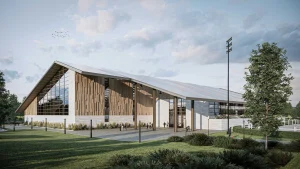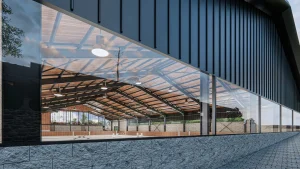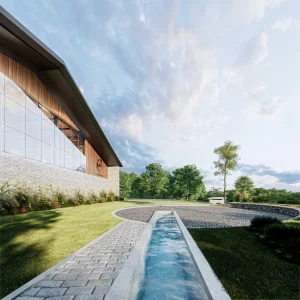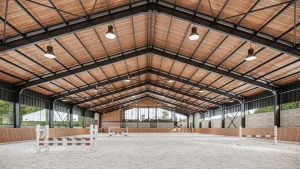The well-being and happiness of horses are closely linked to the quality of their living spaces. Thus, Equine Shelter Design is a crucial aspect that horse owners and designers must carefully consider. These shelters must not only provide physical security but also cater to the emotional and psychological needs of the horses. In this article, we will explore the fundamental principles to consider when designing equine shelters and the challenges that arise during this process.
Equine Shelter Design: Balancing Functionality and Comfort
The primary goal of equine shelter design is to create functional and comfortable spaces where horses can carry out their daily activities with ease. A crucial factor to consider during the design process is the design parameters for creating spaces that meet the horses’ needs. These parameters vary depending on the horses’ requirements and the location of the shelter. For instance, shelters located in open areas might prioritize wind protection and heating systems during colder months.
Equine Shelter Design goes beyond creating spacious areas; it requires thorough planning of every detail. Elements such as the horses’ freedom of movement, safety, and health form the foundation of the design. The interior layout of the shelters should include easily accessible feeding areas, water sources, and rest spaces for the horses. Additionally, the overall arrangement should support the horses’ daily movement routines. Proper care areas, such as cleaning and maintenance zones, should also be integrated to facilitate easy upkeep.
Materials in Equine Shelter Design
The materials used in constructing equine shelters are vital for both durability and comfort. In the Equine Shelter Design process, wood, metal, and brick are commonly preferred materials. Wood, being a natural material, offers an aesthetically pleasing environment and ensures the horses’ comfort. Brick structures, on the other hand, are robust and long-lasting, making them an ideal choice for Equine Shelter Design. The facades of the barns and other exterior elements should also be constructed with durable materials to protect the shelter from external factors.
In more luxurious designs, such as luxurious interiors inspired by European stables, sophisticated materials and decorative elements may be used. These designs combine aesthetics with functionality, creating a pleasant environment for both horses and their owners.
Creating Safe Spaces that Meet Psychological Needs
For horses to live healthily, both their physical and psychological needs must be addressed. Creating safe spaces that meet psychological needs allows horses to lead stress-free, peaceful lives. These areas should allow horses to express their instinctive behaviors, engage in social interactions, and rest comfortably.
In designing equine shelters, it is essential to protect horses from environmental stressors. Factors such as noise, excessive light, or the presence of other animals can disrupt the horses’ tranquility. Therefore, shelters should be constructed in quiet and isolated locations. Furthermore, the interior design of the shelter should create a comfortable and secure environment where horses can feel at ease.
Ventilation and Lighting in Equine Shelter Design
A well-designed Equine Shelter Design also includes ventilation and lighting considerations. Proper ventilation ensures clean airflow within the shelter, protecting the horses’ respiratory health. In enclosed spaces, ventilation systems help prevent the buildup of odors and harmful gases. Additionally, natural light plays a crucial role in regulating the horses’ biological clocks and supporting their overall health. Therefore, it is essential to incorporate adequate windows and lighting systems into the design.
During the determination of design parameters to create spaces, ventilation and lighting should be prioritized. A good design positively impacts the horses’ health and enhances their quality of life.
Key Considerations in Equine Shelter Design
Every detail in equine shelter design must be meticulously planned. Durability, safety, hygiene, and the comfort of the horses are the cornerstones of successful design. During the design process, solutions should be developed that address the horses’ daily needs, and expert opinions should be sought during the determination of design parameters.
Among the considerations during construction, slip-resistant flooring, sturdy building components, and regular maintenance and repair of the shelter are vital. Maintaining hygienic conditions and regularly cleaning the shelter are also essential for the horses’ health.
In conclusion, Equine Shelter Design should be planned to meet the needs of both horses and their owners. A well-designed shelter ensures that horses live comfortably, safely, and healthily. Creating safe spaces that meet both physical and psychological needs should be one of the primary goals of the design process. Constructing safe spaces that meet psychological needs directly impacts the overall health and well-being of the horses.








